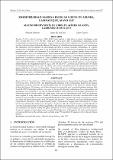Por favor, use este identificador para citar o enlazar este ítem:
https://hdl.handle.net/20.500.12958/3476Registro completo de metadatos
| Campo DC | Valor | Lengua/Idioma |
|---|---|---|
| dc.contributor.author | Ramírez Díaz, Paquita | - |
| dc.contributor.author | De la Cruz Galloso, Jaime | - |
| dc.contributor.author | Castro Gálvez, Javier | - |
| dc.contributor.editor | Instituto del Mar del Perú | - |
| dc.date.accessioned | 2020-11-24T21:52:24Z | - |
| dc.date.available | 2020-11-24T21:52:24Z | - |
| dc.date.issued | 2020 | - |
| dc.identifier.citation | Inf Inst Mar Perú 47(4), 2020, p. 593-606 | es_ES |
| dc.identifier.issn | 0378-7702 | - |
| dc.identifier.uri | https://hdl.handle.net/20.500.12958/3476 | - |
| dc.description.abstract | Entre el 8 y 12 de mayo 2017 se determinó la estructura de las comunidades, en términos de abundancia relativa, riqueza, diversidad y relación con el medio ambiente de las islas Lobos de Afuera (Caleta del Manoa, El Cenicero y Caleta Rinot) en el intermareal y en 16 estaciones del submareal. En los cálculos de diversidad específica se usaron métodos univariados. Se registró composición y abundancia de taxa in situ (mediante buceo) y se recolectaron muestras de comunidades bentónicas para análisis en laboratorio. Las unidades de muestreo en sustrato blando fueron tubos de Penchazadeh y corers y en sustrato rocoso fueron marcos metálicos de 0,0625 m2. En el intermareal rocoso se registraron 12 especies y en el mesolitoral la riqueza estuvo asociada a comunidades de fondos duros, destacando Acanthopleura echinata en Caleta del Manoa (56 ind/m-2) y El Cenicero (24 ind/m-2), en Caleta Rinot predominó Echinolittorina peruviana (136 ind/m-2). El índice de diversidad (H’) promedio por estación varió entre 0,65 bits/ind y 1,72 bits/ind. En el submareal, la riqueza fue de 22 especies. Los principales representantes del megabentos fueron Tegula atra (54 ind.m-2) y Cantharus janelli (24 ind.m-2). El índice de diversidad promedio fue 1,8 bits. La fauna íctica estuvo conformada por 19 especies, destacando los géneros Halichoeres, Chrosmi, Cheilodactylus y Tomicodon chilensis. Se registraron 6 especies de macroalgas: Rhodophyta (4), Chlorophyta (2), predominando Caulerpa filiformis en el submareal e intermareal. En las islas Lobos de Afuera se identificaron 69 especies. | es_ES |
| dc.description.abstract | ABSTRACT: We determined the structure of the communities, based on the relative abundance, richness, diversity, and relationship with the environment of the Lobos de Afuera Islands (Caleta del Manoa, El Cenicero, and Caleta Rinot) in the intertidal and 16 subtidal stations between May 8 and 12, 2017. Univariate methods were used in the specific diversity estimations. Taxa composition and abundance were recorded in situ (by diving) and samples were collected from benthic communities for laboratory analysis. Penchazadeh and corers tubes were used in soft substrates and 0.0625 m2 quadrants were applied in rocky substrates. A total of 12 species were recorded in the rocky intertidal and in the richness in the mesolittoral was associated with hard bottom communities, especially Acanthopleura echinata in Caleta del Manoa (56 ind/m-2) and El Cenicero (24 ind/m-2). Echinolittorina peruviana predominated in Caleta Rinot (136 ind/m-2). The mean diversity index (H’) per station ranged from 0.65 bits/ind to 1.72 bits/ ind. In the subtidal, the richness was 22 species. Tegula atra (54 ind.m-2) and Cantharus janelli (24 ind.m-2) were the main representatives of the megabenthos. The mean diversity index was 1.8 bits. The ichthyofauna was formed by 19 species, mainly the genus Halichoeres, Chrosmi, Cheilodactylus, and Tomicodon chilensis. A total of 6 species of macroalgae were recorded: Rhodophyta (4), Chlorophyta (2), with a predominance of Caulerpa filiformis in the subtidal and intertidal areas. We identified 69 species in the Lobos de Afuera Islands. | - |
| dc.language.iso | spa | es_ES |
| dc.publisher | Instituto del Mar del Perú | es_ES |
| dc.relation.ispartofseries | Informe IMARPE;47(4), 2020 | - |
| dc.rights | info:eu-repo/semantics/openAccess | es_ES |
| dc.rights.uri | https://creativecommons.org/licenses/by/4.0/ | es_ES |
| dc.source | Instituto del Mar del Perú - IMARPE | es_ES |
| dc.source.uri | Repositorio Digital IMARPE | es_ES |
| dc.subject | Biodiversidad marina | es_ES |
| dc.subject | Lambayeque - Isla Lobos de Afuera | es_ES |
| dc.subject | Recursos marinos | es_ES |
| dc.title | Biodiversidad marina en islas Lobos de Afuera, Lambayeque, mayo 2017 | es_ES |
| dc.title.alternative | Marine biodiversity in Lobos de Afuera Islands, Lambayeque (May 2017) | es_ES |
| dc.type | info:eu-repo/semantics/article | es_ES |
| Aparece en las colecciones: | Informe vol. 47(4) 2020 | |
Ficheros en este ítem:
| Fichero | Descripción | Tamaño | Formato | |
|---|---|---|---|---|
| Informe 47(4) art7.pdf | 3,71 MB | Adobe PDF |  Visualizar/Abrir |
Este ítem está sujeto a una licencia Creative Commons Licencia Creative Commons

